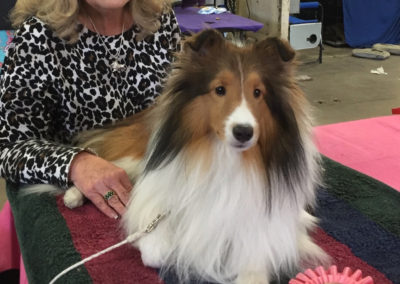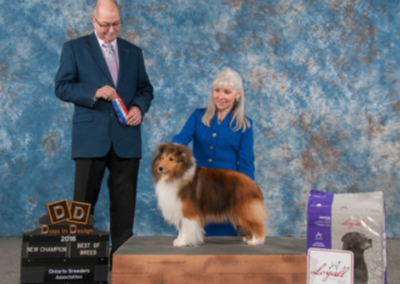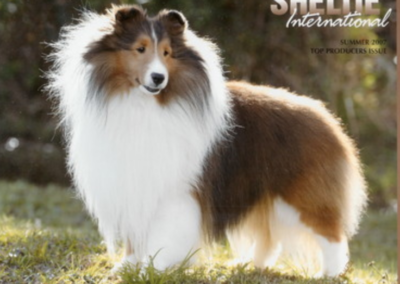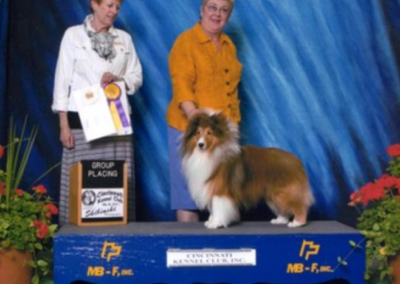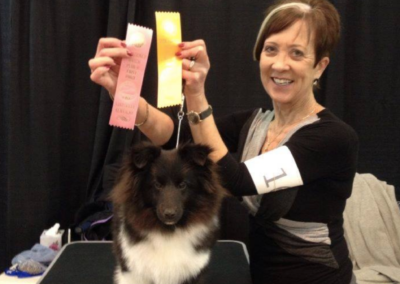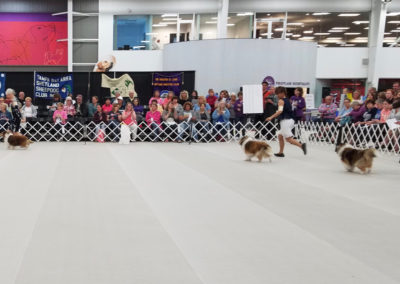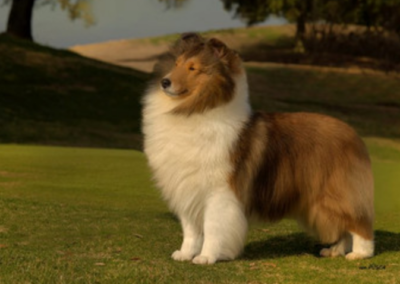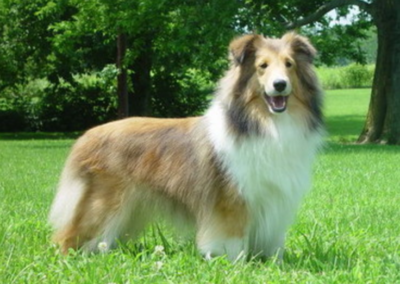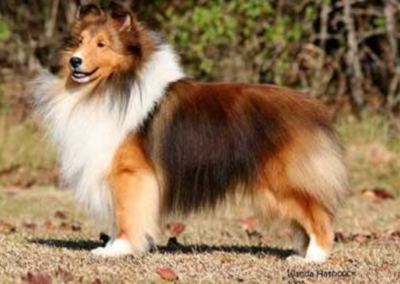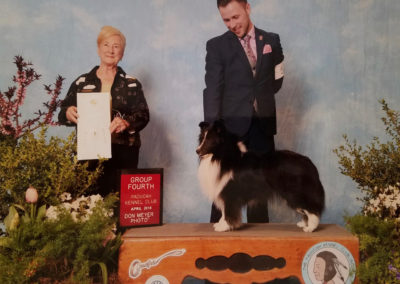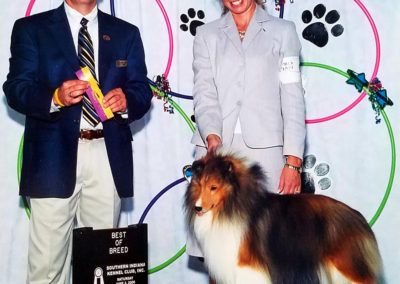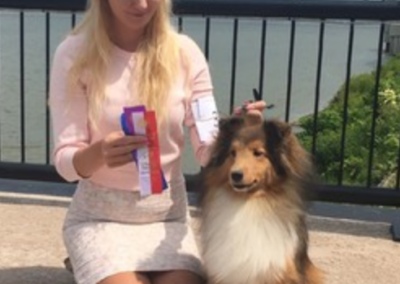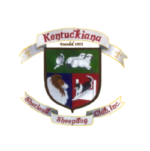
Kentuckiana Shetland Sheepdog Club
Conformation
Dog shows are a venue to evaluate the quality of the exhibiting dogs. The original mission of dog shows was evaluation of breeding stock. Dogs are compared to a written breed standard and how closely they resemble it. The standard represents the ideal Shetland Sheepdog. The judge evaluates the structure and movement of the dog, and then choses the best example/s according to the standard for awards in a variety of classes. Non-champions compete for points toward a Championship. There are classes for puppies, dogs bred by the exhibitor, and open classes. The judge chooses the best of the boy dogs (Winners Dog), and the best of the girl dogs (Winners Bitch) who are awarded points. These two dogs then compete with dogs that are already champions for the Best of Breed trophy. Champions can continue to amass points for Grand Championships. At most shows, the breed winner continues to compete against other breeds in 7 Groups, and perhaps, for Best In Show. These are called All-Breed Shows.
Breed clubs, such as KSSC, hold shows for a single breed. These are called Specialties. KSSC holds two Specialties annually, in March, in conjunction with the Kentuckiana Cluster of Dog Shows at the Louisville Expo Center. See the Calendar for dates and entry information (Premium List). There is also a large All-Breed show at the Kentucky Horse Park on Labor Day weekend. KSSC has designated some of the Sheltie judging at this show as Specialties within the parameters of the All-Breed competition. KSSC members regularly compete in these AKC (American Kennel Club) events as well as other events such as IABCA (International All Breed Canine Association) or UKC (United Kennel Club) conformation venues.
The American Shetland Sheepdog Association (ASSA) is the custodian of the Sheltie breed standard which is approved by the American Kennel Club. It is published here with permission.
KSSC Dogs in Conformation
Shetland Sheepdog Breed Standard
General Appearance
Preamble — The Shetland Sheepdog, like the Collie, traces to the Border Collie of Scotland, which, transported to the Shetland Islands and crossed with small, intelligent, longhaired breeds, was reduced to miniature proportions. Subsequently crosses were made from time to time with Collies. This breed now bears the same relationship in size and general appearance to the Rough Collie as the Shetland Pony does to some of the larger breeds of horses. Although the resemblance between the Shetland Sheepdog and the Rough Collie is marked, there are differences which may be noted. The Shetland Sheepdog is a small, alert, rough-coated, longhaired working dog. He must be sound, agile and sturdy. The outline should be so symmetrical that no part appears out of proportion to the whole. Dogs should appear masculine; bitches feminine.
Size, Proportion, Substance
The Shetland Sheepdog should stand between 13 and 16 inches at the shoulder. Note: Height is determined by a line perpendicular to the ground from the top of the shoulder blades, the dog standing naturally, with forelegs parallel to line of measurement.
Disqualifications— Heights below or above the desired size range are to be disqualified from the show ring.
In overall appearance, the body should appear moderately long as measured from shoulder joint to ischium (rearmost extremity of the pelvic bone), but much of this length is actually due to the proper angulation and breadth of the shoulder and hindquarter, as the back itself should be comparatively short.
Head
The head should be refined and its shape, when viewed from top or side, should be a long, blunt wedge tapering slightly from ears to nose.
Expression— Contours and chiseling of the head, the shape, set and use of ears, the placement, shape and color of the eyes combine to produce expression. Normally the expression should be alert, gentle, intelligent and questioning. Toward strangers the eyes should show watchfulness and reserve, but no fear.
Eyes medium size with dark, almond-shaped rims, set somewhat obliquely in skull. Color must be dark, with blue or merle eyes permissible in blue merles only. Faults– Light, round, large or too small. Prominent haws. Ears small and flexible, placed high, carried three-fourths erect, with tips breaking forward. When in repose the ears fold lengthwise and are thrown back into the frill. Faults– Set too low. Hound, prick, bat, twisted ears. Leather too thick or too thin.
Skull and Muzzle Top of skull should be flat, showing no prominence at nuchal crest (the top of the occiput). Cheeks should be flat and should merge smoothly into a well-rounded muzzle. Skull and muzzle should be of equal length, balance point being inner corner of eye. In profile the top line of skull should parallel the top line of muzzle, but on a higher plane due to the presence of a slight but definite stop. Jaws clean and powerful. The deep, well-developed underjaw, rounded at chin, should extend to base of nostril. Nose must be black. Lips tight. Upper and lower lips must meet and fit smoothly together all the way around. Teeth level and evenly spaced. Scissors bite.
Faults— Two-angled head. Too prominent stop, or no stop. Overfill below, between, or above eyes. Prominent nuchal crest. Domed skull. Prominent cheekbones. Snipy muzzle. Short, receding, or shallow underjaw, lacking breadth and depth. Overshot or undershot, missing or crooked teeth. Teeth visible when mouth is closed.
Neck, Topline, Body
Neck should be muscular, arched, and of sufficient length to carry the head proudly. Faults– Too short and thick.
Back should be level and strongly muscled. Chest should be deep, the brisket reaching to point of elbow. The ribs should be well sprung, but flattened at their lower half to allow free play of the foreleg and shoulder. Abdomen moderately tucked up. Faults– Back too long, too short, swayed or roached. Barrel ribs. Slab-side. Chest narrow and/or too shallow. There should be a slight arch at the loins, and the croup should slope gradually to the rear. The hipbone (pelvis) should be set at a 30-degree angle to the spine. Faults– Croup higher than withers. Croup too straight or too steep.
The tail should be sufficiently long so that when it is laid along the back edge of the hind legs the last vertebra will reach the hock joint. Carriage of tail at rest is straight down or in a slight upward curve. When the dog is alert the tail is normally lifted, but it should not be curved forward over the back.
Faults– Too short. Twisted at end.
Forequarters
From the withers, the shoulder blades should slope at a 45-degree angle forward and downward to the shoulder joints. At the withers they are separated only by the vertebra, but they must slope outward sufficiently to accommodate the desired spring of rib. The upper arm should join the shoulder blade at as nearly as possible a right angle. Elbow joint should be equidistant from the ground and from the withers. Forelegs straight viewed from all angles, muscular and clean, and of strong bone. Pasterns very strong, sinewy and flexible. Dewclaws may be removed. Faults– Insufficient angulation between shoulder and upper arm. Upper arm too short. Lack of outward slope of shoulders. Loose shoulders. Turning in or out of elbows. Crooked legs. Light bone.
Feet should be oval and compact with the toes well arched and fitting tightly together. Pads deep and tough, nails hard and strong. Faults– Feet turning in or out. Splay feet. Hare feet. Cat feet.
Hindquarters
The thigh should be broad and muscular. The thighbone should be set into the pelvis at a right angle corresponding to the angle of the shoulder blade and upper arm. Stifle bones join the thighbone and should be distinctly angled at the stifle joint. The overall length of the stifle should at least equal the length of the thighbone, and preferably should slightly exceed it. Hock joint should be clean-cut, angular, sinewy, with good bone and strong ligamentation. The hock (metatarsus) should be short and straight viewed from all angles. Dewclaws should be removed. Faults– Narrow thighs. Cow-hocks. Hocks turning out. Poorly defined hock joint.
Feet as in forequarters.
Coat
The coat should be double, the outer coat consisting of long, straight, harsh hair; the undercoat short, furry, and so dense as to give the entire coat its “standoff” quality. The hair on face, tips of ears and feet should be smooth. Mane and frill should be abundant, and particularly impressive in males. The forelegs well feathered, the hind legs heavily so, but smooth below the hock joint. Hair on tail profuse. Note: Excess-hair on ears, feet, and on hocks may be trimmed for the show ring. Faults– Coat short or flat, in whole or in part; wavy, curly, soft or silky. Lack of undercoat. Smooth-coated specimens.
Color
Black, blue merle, and sable (ranging from golden through mahogany); marked with varying amounts of white and/or tan. Faults– Rustiness in a black or a blue coat. Washed-out or degenerate colors, such as pale sable and faded blue. Self-color in the case of blue merle, that is, without any merling or mottling and generally appearing as a faded or dilute tri-color. Conspicuous white body spots. Specimens with more than 50 percent white shall be so severely penalized as to effectively eliminate them from competition. Disqualification— Brindle.
Gait
The trotting gait of the Shetland Sheepdog should denote effortless speed and smoothness. There should be no jerkiness, nor stiff, stilted, up-and-down movement. The drive should be from the rear, true and straight, dependent upon correct angulation, musculation, and ligamentation of the entire hindquarter, thus allowing the dog to reach well under his body with his hind foot and propel himself forward. Reach of stride of the foreleg is dependent upon correct angulation, musculation and ligamentation of the forequarters, together with correct width of chest and construction of rib cage. The foot should be lifted only enough to clear the ground as the leg swings forward. Viewed from the front, both forelegs and hindlegs should move forward almost perpendicular to ground at the walk, slanting a little inward at a slow trot, until at a swift trot the feet are brought so far inward toward center line of body that the tracks left show two parallel lines of footprints actually touching a center line at their inner edges. There should be no crossing of the feet nor throwing of the weight from side to side.
Faults— Stiff, short steps, with a choppy, jerky movement. Mincing steps, with a hopping up and down, or a balancing of weight from side to side (often erroneously admired as a “dancing gait” but permissible in young puppies). Lifting of front feet in hackney-like action, resulting in loss of speed and energy. Pacing gait.
Temperament
The Shetland Sheepdog is intensely loyal, affectionate, and responsive to his owner. However, he may be reserved toward strangers but not to the point of showing fear or cringing in the ring. Faults— Shyness, timidity, or nervousness. Stubbornness, snappiness, or ill temper.
Disqualifications
Heights below or above the desired size range, i.e., 13-16 inches.
Brindle color.
| General Appearance | ||
| Symmetry | 10 | |
| Temperament | 10 | |
| Coat | 5 | 25 |
| Head | ||
| Skull and stop | 5 | |
| Muzzle | 5 | |
| Eyes, ears and expression | 10 | 20 |
| Body | ||
| Neck and back | 5 | |
| Chest, ribs and brisket | 10 | |
| Loin, croup and tail | 5 | 20 |
| Forequarters | ||
| Shoulder | 10 | |
| Forelegs and feet | 5 | 15 |
| Hindquarters | ||
| Hip, thigh and stifle | 10 | |
| Hocks and feet | 5 | 15 |
| Gait | ||
| Gait–smoothness and lack of wastedmotion when trotting | 5 | 5 |
| Total | 100 |
AKC Approved May 12, 1959
During my 36 years of showing in conformation, my daughter and I shared duties. I would bathe and groom; she would add the finishing touches, take our Sheltie into the ring, and present to the Judge. Winning our classes and finishing our dog together was the highlight of our days.
On August 1, 2017, I became the new owner of JW (Raisin True Grit) aka John Wayne out of Raisin Born This Way (Bernadette), sired by Ch Raisin A Lion in Winter (Oshie). JW was eleven months at the time and had spent his early months in the loving lap of Larry Guihen or running on Linda and Larry’s farm. We quickly bonded and enjoyed many out of town getaways including a fun two weeks of attending the January Florida circuit of dog shows. I bought JW as a show prospect, but due to other life events have not been in a position to show him yet. With absolutely no experience in the show ring, on mats, on the table, or examined by a stranger/judge, I entered him in the Kentuckiana Cluster of Dog Shows AKC Sanctioned B Match in Louisville on March 15, 2018. Our good friend, Jennie Lamb piloted JW in the ring. JW captured a Group First in the Adult Herding Group. On to Best of Match, he was one of the three pulled from the seven group winners in determining the Adult Best of Match! I am so happy and proud of this little guy. I am looking forward to having a lot of fun with him!
Next Membership Meeting
TBA
Location: TBA
Time: TBA
Contact: president@kyinssc.org for details
What's on your mind?
Send us a message.
Questions, comments, problems or suggestions about our Website, please send them to president@kyinssc.org
Legal: Copyright Notice | Privacy Policy | Disclaimer | Terms and Conditions
Designed with Elegant Themes | Powered by Word Press | Hosted by Iglou | copyright © 2018 The Kentuckiana Shetland Sheepdog Club, Inc.
